WRC
The FIA World Rally Championship (WRC) pits cars and drivers in a series of three-day events against some of the toughest, and most varied, conditions on the planet - from the ice and snow of Scandinavia to the stifling heat of Greece - over surfaces ranging from smooth tarmac to boulder-strewn rocky tracks. Because the conditions are so varied and unforgiving, cars visit a 'service park' at pre-determined times during each event. Besides interrogating data from the on-board data systems, changing tyres and making running adjustments, during this time a team of four technicians is allowed to perform mechanical work on each car. The time available is strictly limited, with each stop being either 10, 30 or 45 minutes depending on the itinerary. At the end of each season, the FIA awards the winning driver and winning manufacturer with the WRC championship title.
All cars competing at the top level of the WRC are based on four-cylinder two-litre production cars. But although they look similar to the ones in a high street showroom, changes allowed to the engine, transmission and suspension, mean a WRC car is a turbocharged, four wheel drive monster that develops around 300bhp and masses of torque. Inside a WRC car there is no fancy upholstery or elaborate trim - just painted metal, composite panels and two carbon fiber seats that are tailored to the driver and co-driver. Rally rules allow spoilers and other aerodynamic aids that you will not see on a road car. The result is a car that reaches 100kph in around three seconds on all surfaces and can - in the right hands - power slide between the trees on a narrow gravel track under full control at 200kph-plus.
Suzuki World Rally Team
The World Rally Championship is with good reason extremely popular in Europe. Reason enough for Suzuki to release a limited edition of their SX4 'Urban Cross Car' with a WRC theme.
Suzuki Germany will build 500 numbered copies of the SX4 WRC with 1.6 liter, 107 hp gasoline engine with a price tag of Euro 19,500. For this money you get an SX4 with rally design and Suzuki Accessories like 16 inch wheels (205/60 R 16), body kit consisting of a new front, side and rear spoilers, sport grille and carbon-look details. Inside Suzuki fitted a leather shift knob and carbon details joining the regular features like CD-Radio-Navigation system, privacy glass and key-less Entry and Start.
For Suzuki, the move into WRC was short-lived. It first entered the World Rally Championship just this year with two SX4's and finished fifth in the manufacturers standings. Suzuki cited the global economic turmoil and the precipitous decline in auto sales as the reason they are pulling out of WRC racing.
Suzuki WRC fans have something to cheer about for the first time in four months. Yes, it's been that long since the Japanese automaker announced it would with draw from the World Rally Championship, but now it seems they may already be planning a return.
Engine
Configuration: J20 Straight 4
Location: Front, transversely mounted
Construction: alloy block and head
Displacement: 1.997 liter / 121.9 cu in
Valvetrain: 4 valves / cylinder, DOHC
Fuel feed: Fuel Injection
Aspiration: Turbo
Dimensions
Weight: 1230 kilo / 2711.7 lbs
Length / Width / Height: 4135 mm (162.8 in) / 1770 mm (69.7 in) / 1450 mm (57.1 in)
Wheelbase / Track (fr/r): 2500 mm (98.4 in) / N/A / N/A
Drivetrain
Chassis/body: unitary steel
Suspension: McPherson struts with coil springs over Reiger shock absorbers
Steering: rack-and-pinion, power assisted
Brakes: ventilated discs, all-round
Gearbox: 5 speed Sequential
Drive: All wheel drive
Performance figures
Power: 320 bhp / 239 KW @ 4000 rpm
Torque: 590 Nm / 435 ft lbs @ 3500 rpm
BHP/Liter: 160 bhp / liter
Power to weight: 0.26 bhp / kg
WRC Suzuki SX4 Gallery
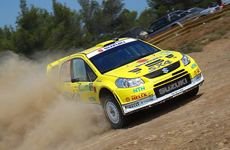 | 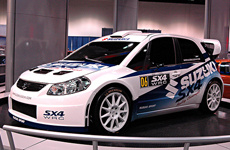 | 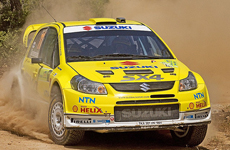 |
||
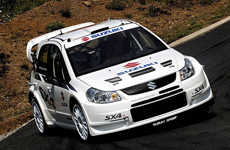 | 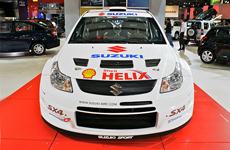 | 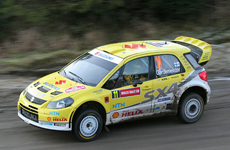 |
Subaru World Rally Team
The most visually distinguishing element, and the first thing people will notice about the Impreza WRC2008, is the radically restyled bodyshell. No longer the iconic saloon of old, which captured the hearts of so many and sculpted a following of die-hard enthusiasts, the first five door Impreza World Rally Car mimics Subaru's latest road-going incarnation.
Launched to critical acclaim, it is also the first Impreza World Rally Car to not sport Subaru's trademark bonnet scoop. The car retains a front-mounted intercooler and the air intake takes the form of an internal scoop fed from a grill in the front bumper.
Continuing the trend of parallel development between the Impreza World Rally Cars and Subaru's road-going counterparts, Petter Solberg and SWRT engineers were jointly involved with the creation of the Impreza STI road car from its infancy. The car was designed from the outset with consideration as to its suitability as a future rallying contender.
The longer wheel base, shortened overhangs and improved aerodynamics visible in the new car were all incorporated by Subaru Accessories for the benefit of both the production and World Rally variants. SWRT then assessed the performance of every component and element of the car to optimise the centre of gravity and weight distribution, shedding any limitations or constraints carried across from the outgoing Impreza.
Revised and refreshed, the WRC2008's powerplant is the only element not to have been radically reworked due to the World Rally Championship regulations. Nevertheless, the two litre flat-four's manifolds, the coolant and intercooler systems and ancillaries have been redesigned to nestle within the confines of the new engine bay.
Drivetrain
Transmission:5 Speed Manual
Layout: Front Engine, AWD
Final Drive Ratio: 3.90:1
Differential: Viscous-Coupling Locking Center Differential
Suspension: 4 Wheel Independent
Exterior
Wheelbase: 103.1 in.
Width: 68.5 in.
Height: 58.1 in.
Length : 180.3 in.
Wheels: 17x7 JJ 10-Spoke Aluminum Alloy
Tires: 225/45R17 Summer Performance
Engine
Engine Type: Turbocharged Horizontally-Opposed "Boxer" 4 Cylinder
Displacement: 2457 cc
Horsepower: 265 @ 6000 rpm
Torque: 244 lb-ft. @ 4000 rpm
Bore X Stroke: 99.5 x 79 mm (3.92 x 3.11 in.)
Compression Ratio: 8.4:1
WRC Subaru Impreza WRX STI Gallery
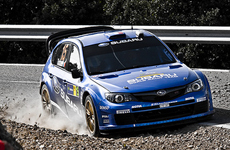 | 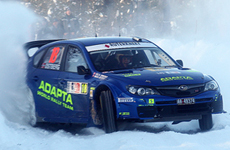 | 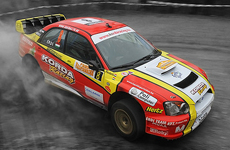 |
||
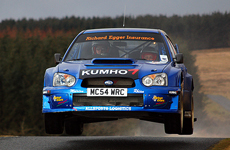 | 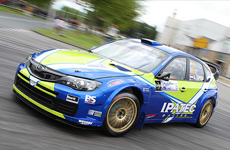 | 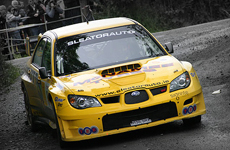 |
WRC Subaru Impreza WRX STI Spoiler
Ford World Rally Team
Ford of Europe revealed the exciting new look for its 2008 FIA World Rally Championship campaign as the team was unveiled at the Autosport International Show in Birmingham.
The Focus RS World Rally Car, which powered Ford Accessories & Parts to the manufacturers' world title in both 2006 and 2007, sports a striking modern livery that took centre stage today at Europe's largest annual motorsport exhibition. It was also announced that the squad will be named the BP Ford Abu Dhabi World Rally Team for 2008.
The team's new driver line-up of Mikko Hirvonen and Jari-Matti Latvala were joined by Ford of Europe's new motorsport director, Mark Deans, and team director Malcolm Wilson as they revealed the Focus RS WRC's colour scheme for the first time.
"The Focus RS WRC has a new, contemporary livery which blends perfectly with the outlook of the BP Ford Abu Dhabi World Rally Team," explained Deans. "This is our first full season in partnership with BP and the Abu Dhabi Tourism Authority and their importance to our WRC program is reflected in the team's new name and their prominence on the car.
Engine
Type: Turbocharged Inline-4
Displacement cu in (cc): 123 (2000)
Power bhp (kW) at RPM: 300(224) / 6000
Torque lb-ft (Nm) at RPM: 406(550) / 4000
Redline at RPM: n.a.
Exterior
Chassis
Brakes F/R: vented disc/vented disc
Tires F-R: Gravel: R15 (magnesium) Asphalt: R18 (magnesium)
Driveline: All Wheel Drive
Exterior
Length/ Width/ Height in: 170.1/ 70.2/ n.a. (depends on the setup)
Weight lb (kg): 2711 (1230)
WRC Ford Focus Gallery
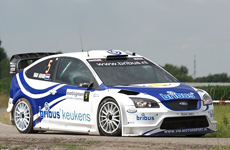 | 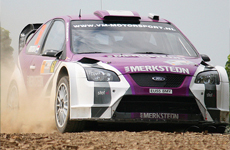 | 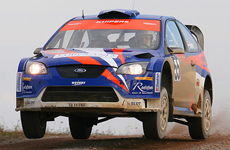 |
||
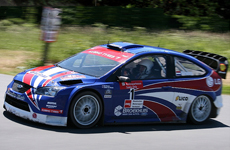 | 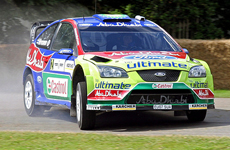 | 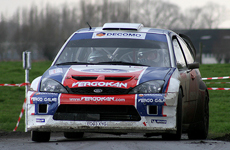 |
WRC Ford Focus Spoiler
Mitsubishi World Rally Team
An explanation may be needed for Mitsubishi names and Lancer model identification. Throughout the Lancer Evo versions, there have been so far 3 different models/generations of Lancer. Completely different than any other car manufacturer, Mitsubishi carries on counting Evo numbers respectable of model changes among Mitsubishi Accessories. The EvoI-III is known as the Lancer everywhere. The EvoIV-VI changed name to Carisma in Europe and even was rallied under both names, Lancer & Carisma. From EvoVII Lancer replaced the Carisma name in Europe while in Japan the Lancer name was abandoned for Cedia.
Many people claim Mitsubishi came way too late with their WRCar as they stuck to the group A Lancer until mid 2001, over 4 years after the WRCar rules were introduced. However the last Lancer EvoVI or even with minor changes EvoVI.5 already used WRCar freedom to some degree, i.e. with rear axle wheel travel and with the differentials. However it is also fact that the Lancer WRC had a difficult start. It was surprising little improvement over the more restricted group A car and when the once so successful Mitsubishi team pulled the plug at the end of 2002, it came as little surprise.
One year later Mitsubishi was back with a new team, a new engineer and a new car. In fact the car was still based on the same road car model, such there is, well, the same base. But Mitsubishi had addressed about every single area of the car. The Lancer WRC04 and the Lancer WRC Step2 of 2002 share the very same base, but the differences may be just as big as they were between their last gA and first WRCar.
However now other things were getting in the way. In 2005 it looked like at long last they have created a real front runner again. But regulation changes in the WRC concerning points scoring systems (nominations), number of events and choice of events, led to Mitsubishi withdrawing together with Skoda and Peugeot. That the performance potential of last Lancer WRC was this time not the reason for Mitsubishi's withdrawal may be underlined by the fact that Toni Gardemeister and Xavier Pons competed in the 2007 WRC without any works support, and they did look competitive, despite their Lancer WRC05 being a 2 years older evolution than all their competition.
Engine
Configuration: 4G63 Straight 4
Location: Front, transversely mounted
Displacement: 1.996 liter / 121.8 cu in
Bore / Stroke: 85.5 mm (3.4 in) / 86.9 mm (3.4 in)
Valvetrain: 4 valves / cylinder, DOHC
Fuel feed: Electronic Fuel Injection
Aspiration: Intercooled Single Scroll Turbocharger
Dimensions
Weight: 1230 kilo / 2711.7 lbs
Length / Width / Height: 4360 mm (171.7 in) / 1770 mm (69.7 in) / N/A
Wheelbase / Track (fr/r): 2600 mm (102.4 in) / 1550 mm (61 in) / 1550 mm (61 in)
Drivetrain
Chassis/body: unitary steel
Suspension (fr/r): McPherson struts, coil springs, Ohlins adjustable dampers
Steering: rack-and-pinion, power assisted
Brake: ventilated discs, all-round
Gearbox: INVECS 6 speed Sequential
Drive: All wheel drive
Performance figures
Power: 300 bhp / 224 KW @ 5500 rpm
Torque: 540 Nm / 398 ft lbs @ 3500 rpm
BHP/Liter: 150 bhp / liter
Power to weight:0.24 bhp / kg
WRC Mitsubishi Lancer Evolution Gallery
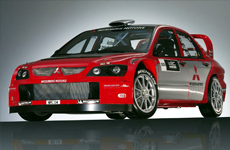 | 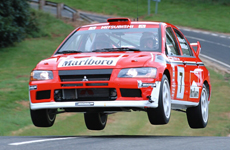 | 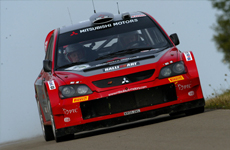 |
||
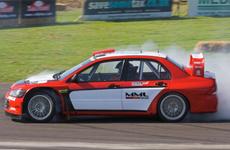 | 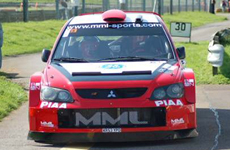 | 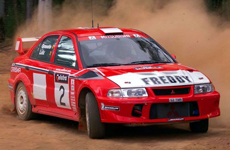 |